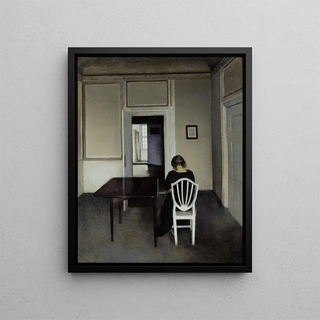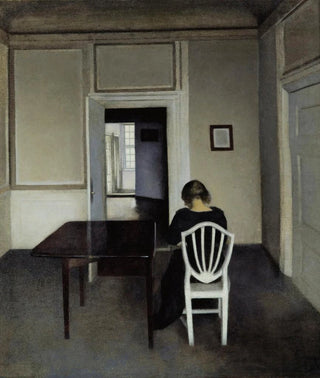Art print | Interior with Ida in a white chair - Vilhelm Hammershøi


View from behind

Frame (optional)
Interior with Ida in a white chair - Vilhelm Hammershøi – Captivating introduction
In the fascinating world of art, some works capture not only a moment but also the essence of an atmosphere, a feeling. "Interior with Ida in a white chair" by Vilhelm Hammershøi is one of those creations that transcends the simple frame of a canvas. Immersing us in the intimacy of a Danish interior, Hammershøi invites us to share a suspended moment, where silence becomes palpable and light plays a central role. This piece, both delicate and powerful, evokes a gentle melancholy, a reflection on solitude and introspection.
Style and uniqueness of the work
Hammershøi's style is characterized by a unique approach to light and space. In "Interior with Ida in a white chair," he manages to create a harmonious composition where each element seems to have its precise place. The color palette, often limited to soft and neutral tones, reinforces the idea of a calming inner world. The use of natural light, filtered through discreet windows, gives the scene an almost ethereal dimension. The figure of Ida, seated in her white chair, embodies a presence that is both strong and vulnerable. Her gaze, turned outward, sparks curiosity in the viewer, who wonders what she observes, what thoughts assail her. Hammershøi thus manages to establish a silent dialogue between the artwork and the observer, making each look at the canvas unique and personal.
The artist and his influence
Vilhelm Hammershøi, Danish painter of the early 20th century, is often considered one of the masters of intimate realism. His work, though not prolific, has had a significant impact on modern art. Hammershøi draws inspiration from the atmosphere of bourgeois interiors of his time, but he transcends mere decor to explore universal themes such as solitude, the passage of time, and the search for self. His influence is felt among many contemporary artists, who admire his ability to capture the essence of human intimacy. By reinterpreting scenes from the

Matte finish

View from behind

Frame (optional)
Interior with Ida in a white chair - Vilhelm Hammershøi – Captivating introduction
In the fascinating world of art, some works capture not only a moment but also the essence of an atmosphere, a feeling. "Interior with Ida in a white chair" by Vilhelm Hammershøi is one of those creations that transcends the simple frame of a canvas. Immersing us in the intimacy of a Danish interior, Hammershøi invites us to share a suspended moment, where silence becomes palpable and light plays a central role. This piece, both delicate and powerful, evokes a gentle melancholy, a reflection on solitude and introspection.
Style and uniqueness of the work
Hammershøi's style is characterized by a unique approach to light and space. In "Interior with Ida in a white chair," he manages to create a harmonious composition where each element seems to have its precise place. The color palette, often limited to soft and neutral tones, reinforces the idea of a calming inner world. The use of natural light, filtered through discreet windows, gives the scene an almost ethereal dimension. The figure of Ida, seated in her white chair, embodies a presence that is both strong and vulnerable. Her gaze, turned outward, sparks curiosity in the viewer, who wonders what she observes, what thoughts assail her. Hammershøi thus manages to establish a silent dialogue between the artwork and the observer, making each look at the canvas unique and personal.
The artist and his influence
Vilhelm Hammershøi, Danish painter of the early 20th century, is often considered one of the masters of intimate realism. His work, though not prolific, has had a significant impact on modern art. Hammershøi draws inspiration from the atmosphere of bourgeois interiors of his time, but he transcends mere decor to explore universal themes such as solitude, the passage of time, and the search for self. His influence is felt among many contemporary artists, who admire his ability to capture the essence of human intimacy. By reinterpreting scenes from the






